air conditioning CITROEN DS4 2018 Owners Manual
[x] Cancel search | Manufacturer: CITROEN, Model Year: 2018, Model line: DS4, Model: CITROEN DS4 2018Pages: 296, PDF Size: 9.91 MB
Page 4 of 296
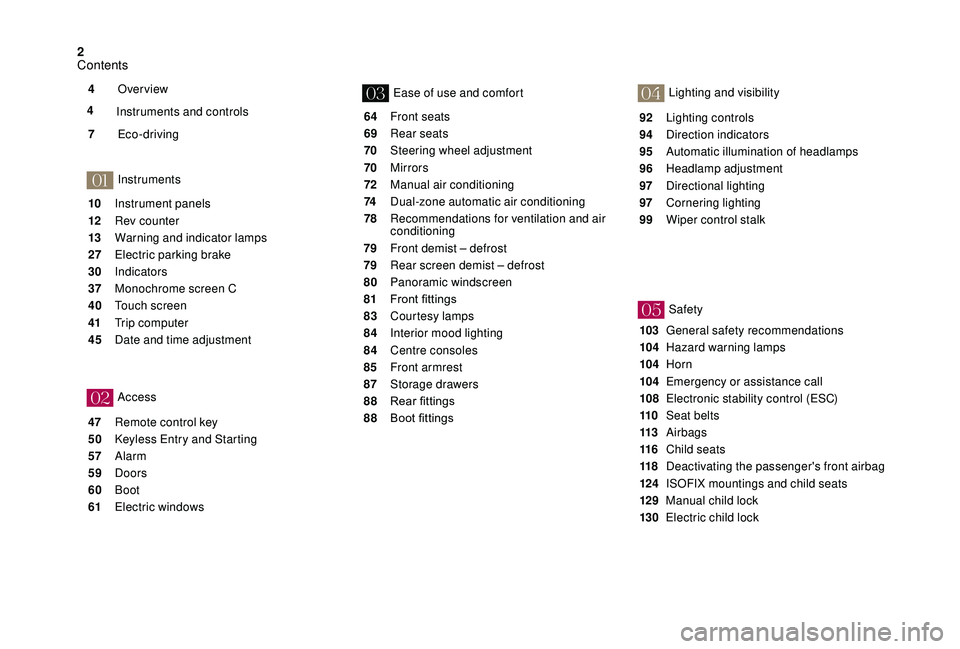
2
01
02
0304
05
10 Instrument panels
12
R
ev counter
13
W
arning and indicator lamps
27
E
lectric parking brake
30
I
ndicators
37
M
onochrome screen C
40
T
ouch screen
41
T
rip computer
45
D
ate and time adjustment
47
R
emote control key
50
K
eyless Entry and Starting
57
Alarm
59
Doors
60
Boot
61
E
lectric windows 64
F
ront seats
69
R
ear seats
70
S
teering wheel adjustment
70
M
irrors
72
M
anual air conditioning
74 D ual-zone automatic air conditioning
78 R ecommendations for ventilation and air
conditioning
79
F
ront demist – defrost
79
R
ear screen demist – defrost
80
P
anoramic windscreen
81 Front
fittings
83
C
ourtesy lamps
84
I
nterior mood lighting
84
C
entre consoles
85
Fr
ont armrest
87
St
orage drawers
88 Rear
fi
ttings
88 Boot
fittings92
L
ighting controls
94
D
irection indicators
95
A
utomatic illumination of headlamps
96
H
eadlamp adjustment
97
D
irectional lighting
97 C ornering lighting
99
W
iper control stalk
103
G
eneral safety recommendations
104
H
azard warning lamps
104
Horn
104
E
mergency or assistance call
108
E
lectronic stability control (ESC)
110
Se
at belts
113
Airbags
116
Ch
ild seats
118
D
eactivating the passenger's front airbag
124
I
SOFIX mountings and child seats
129
M
anual child lock
130
E
lectric child lock
Over view
Instruments
Access Ease of use and comfort
Safety Lighting and visibility
Eco-driving
7 4
4 Instruments and controls
Contents
Page 6 of 296
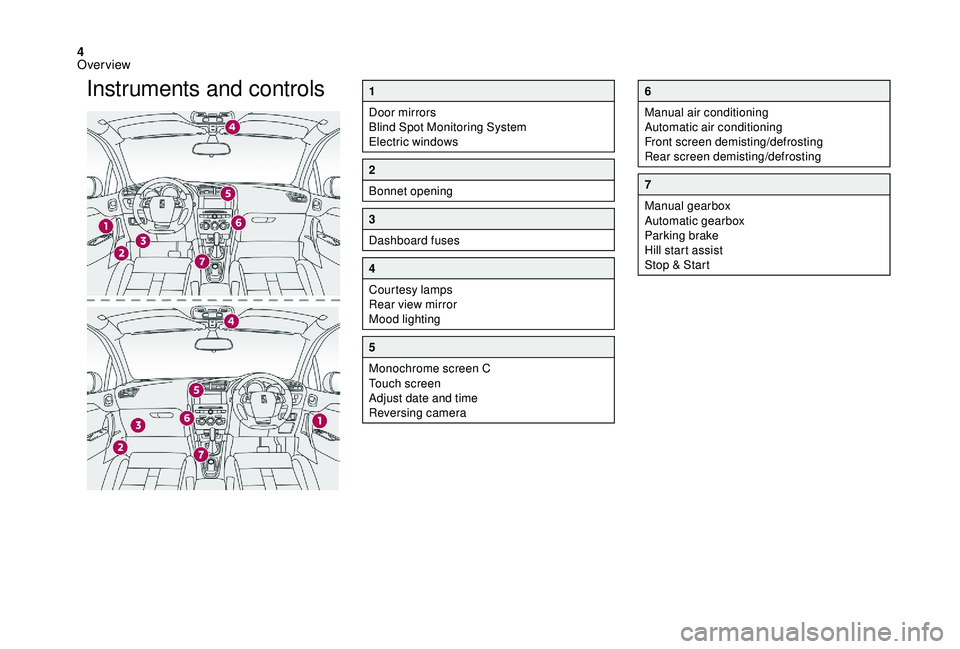
4
Instruments and controls1
Door mirrors
Blind Spot Monitoring System
Electric windows
2
Bonnet opening
3
Dashboard fuses
4
Courtesy lamps
Rear view mirror
Mood lighting
5
Monochrome screen C
Touch screen
Adjust date and time
Reversing camera
6
Manual air conditioning
Automatic air conditioning
Front screen demisting/defrosting
Rear screen demisting/defrosting
7
Manual gearbox
Automatic gearbox
Parking brake
Hill start assist
Stop & Start
Over view
Page 9 of 296
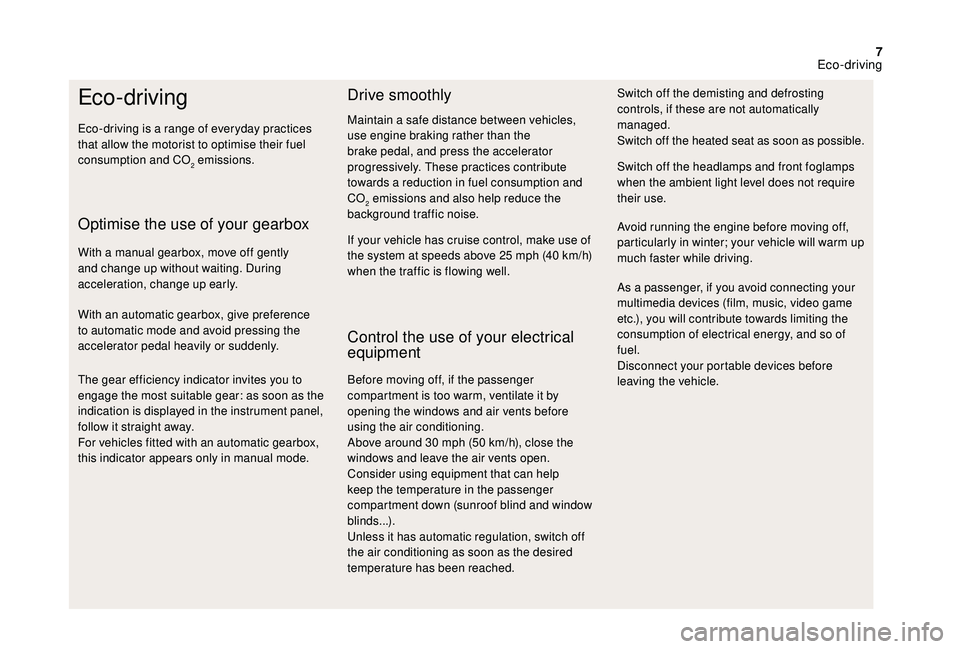
7
Eco-driving
Eco-driving is a range of everyday practices
that allow the motorist to optimise their fuel
consumption and CO
2 emissions.
Optimise the use of your gearbox
With a manual gearbox, move off gently
and change up without waiting. During
acceleration, change up early.
With an automatic gearbox, give preference
to automatic mode and avoid pressing the
accelerator pedal heavily or suddenly.
The gear efficiency indicator invites you to
engage the most suitable gear: as soon as the
indication is displayed in the instrument panel,
follow it straight away.
For vehicles fitted with an automatic gearbox,
this indicator appears only in manual mode.
Drive smoothly
Maintain a safe distance between vehicles,
use engine braking rather than the
brake pedal, and press the accelerator
progressively. These practices contribute
towards a reduction in fuel consumption and
CO
2 emissions and also help reduce the
background traffic noise.
If your vehicle has cruise control, make use of
the system at speeds above 25 mph (40 km/h)
when the traffic is flowing well.
Control the use of your electrical
equipment
Before moving off, if the passenger
compartment is too warm, ventilate it by
opening the windows and air vents before
using the air conditioning.
Above around 30 mph (50 km/h), close the
windows and leave the air vents open.
Consider using equipment that can help
keep the temperature in the passenger
compartment down (sunroof blind and window
blinds...).
Unless it has automatic regulation, switch off
the air conditioning as soon as the desired
temperature has been reached. Switch off the headlamps and front foglamps
when the ambient light level does not require
their use.
Avoid running the engine before moving off,
particularly in winter; your vehicle will warm up
much faster while driving. Switch off the demisting and defrosting
controls, if these are not automatically
managed.
Switch off the heated seat as soon as possible.
As a passenger, if you avoid connecting your
multimedia devices (film, music, video game
etc.), you will contribute towards limiting the
consumption of electrical energy, and so of
fuel.
Disconnect your portable devices before
leaving the vehicle.
Eco-driving
Page 74 of 296
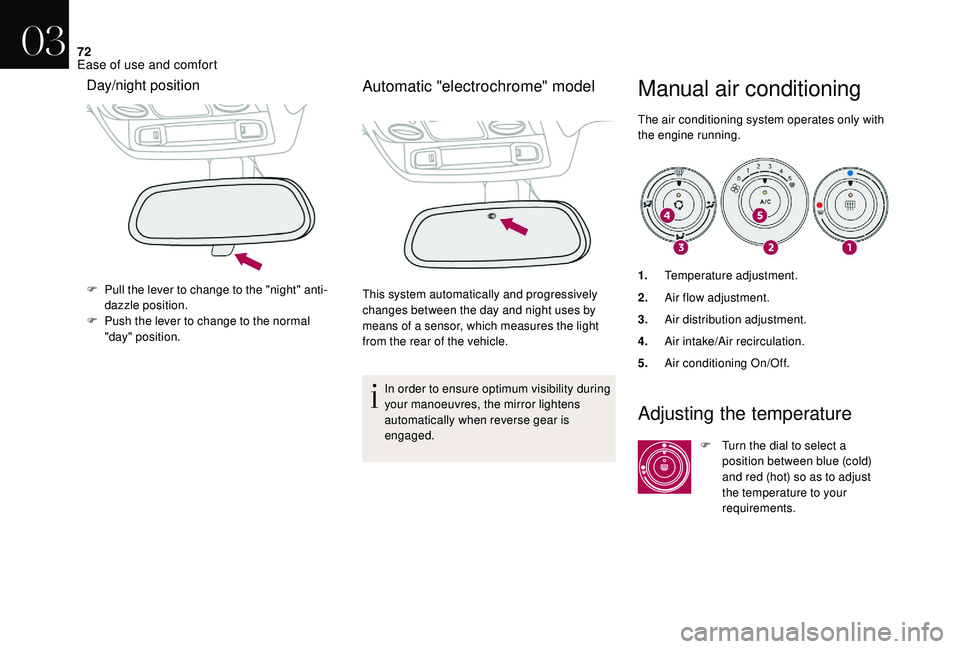
72
Manual air conditioning
The air conditioning system operates only with
the engine running.
Day/night position
F Pull the lever to change to the "night" anti-dazzle position.
F
P
ush the lever to change to the normal
"day" position.
Automatic "electrochrome" model
This system automatically and progressively
changes between the day and night uses by
means of a sensor, which measures the light
from the rear of the vehicle.
In order to ensure optimum visibility during
your manoeuvres, the mirror lightens
automatically when reverse gear is
engaged. 1.
Temperature adjustment.
2. Air flow adjustment.
3. Air distribution adjustment.
4. Air intake/Air recirculation.
5. Air conditioning On/Off.
Adjusting the temperature
F Turn the dial to select a
position between blue (cold)
and red (hot) so as to adjust
the temperature to your
requirements.
03
Ease of use and comfort
Page 75 of 296
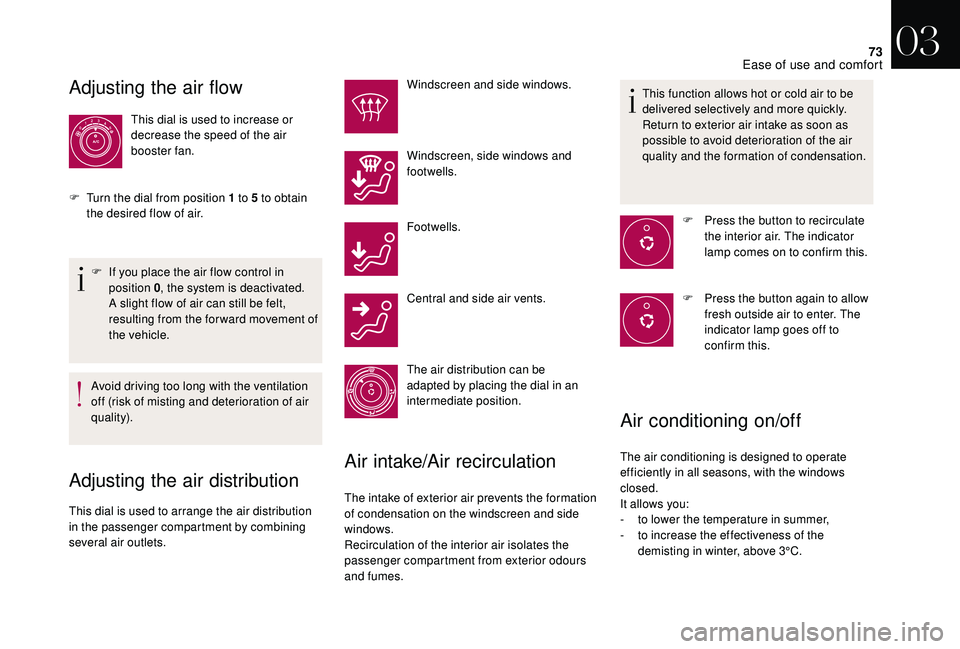
73
Adjusting the air flow
This dial is used to increase or
decrease the speed of the air
booster fan.
F
T
urn the dial from position 1 to 5 to obtain
the desired flow of air.
F
I
f you place the air flow control in
position 0 , the system is deactivated.
A slight flow of air can still be felt,
resulting from the for ward movement of
the vehicle.
Avoid driving too long with the ventilation
off (risk of misting and deterioration of air
quality).
Adjusting the air distribution
This dial is used to arrange the air distribution
in the passenger compartment by combining
several air outlets. Windscreen and side windows.
Windscreen, side windows and
footwells.
Footwells.
Central and side air vents.
The air distribution can be
adapted by placing the dial in an
intermediate position.
Air intake/Air recirculation
The intake of exterior air prevents the formation
of condensation on the windscreen and side
windows.
Recirculation of the interior air isolates the
passenger compartment from exterior odours
and fumes.This function allows hot or cold air to be
delivered selectively and more quickly.
Return to exterior air intake as soon as
possible to avoid deterioration of the air
quality and the formation of condensation.
F
P
ress the button to recirculate
the interior air. The indicator
lamp comes on to confirm this.
F
P
ress the button again to allow
fresh outside air to enter. The
indicator lamp goes off to
confirm this.
Air conditioning on/off
The air conditioning is designed to operate
efficiently in all seasons, with the windows
closed.
It allows you:
-
t
o lower the temperature in summer,
-
t
o increase the effectiveness of the
demisting in winter, above 3°C.
03
Ease of use and comfort
Page 76 of 296
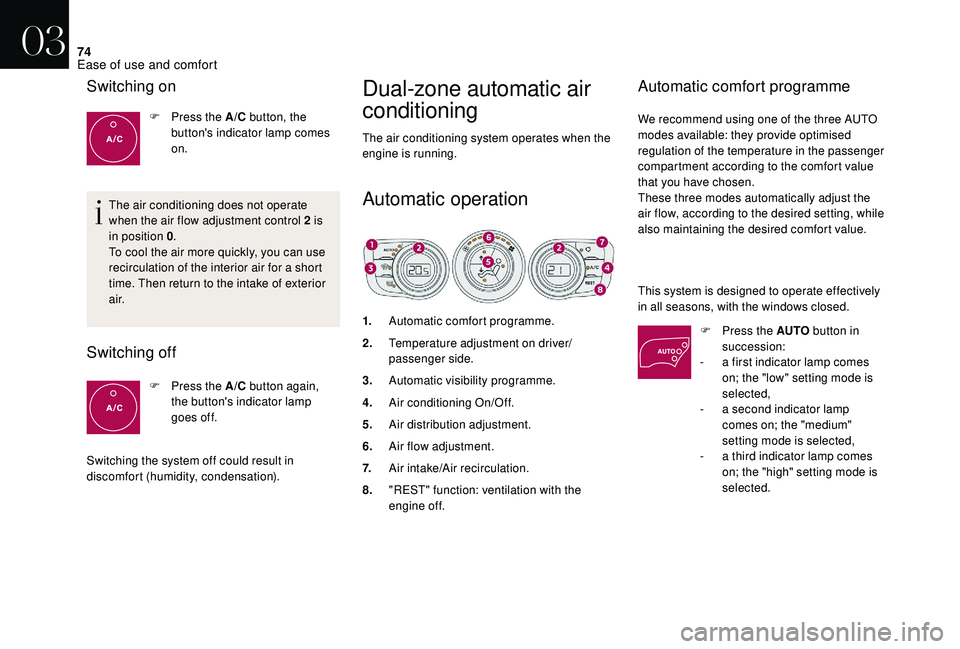
74
Dual-zone automatic air
conditioning
The air conditioning system operates when the
engine is running.
1.Automatic comfort programme.
2. Temperature adjustment on driver/
passenger side.
3. Automatic visibility programme.
4. Air conditioning On/Off.
5. Air distribution adjustment.
6. Air flow adjustment.
7. Air intake/Air recirculation.
8. "REST" function: ventilation with the
engine off.
Switching on
F Press the A/C button, the
button's indicator lamp comes
on.
The air conditioning does not operate
when the air flow adjustment control 2 is
in position 0 .
To cool the air more quickly, you can use
recirculation of the interior air for a short
time. Then return to the intake of exterior
a i r.
Switching off
F Press the A/C button again,
the button's indicator lamp
goes off.
Switching the system off could result in
discomfort (humidity, condensation).
Automatic operation
Automatic comfort programme
We recommend using one of the three AUTO
modes available: they provide optimised
regulation of the temperature in the passenger
compartment according to the comfort value
that you have chosen.
These three modes automatically adjust the
air flow, according to the desired setting, while
also maintaining the desired comfort value.
This system is designed to operate effectively
in all seasons, with the windows closed. F
P
ress the AUTO button in
succession:
-
a f
irst indicator lamp comes
on; the "low" setting mode is
selected,
-
a s
econd indicator lamp
comes on; the "medium"
setting mode is selected,
-
a t
hird indicator lamp comes
on; the "high" setting mode is
selected.
03
Ease of use and comfort
Page 77 of 296
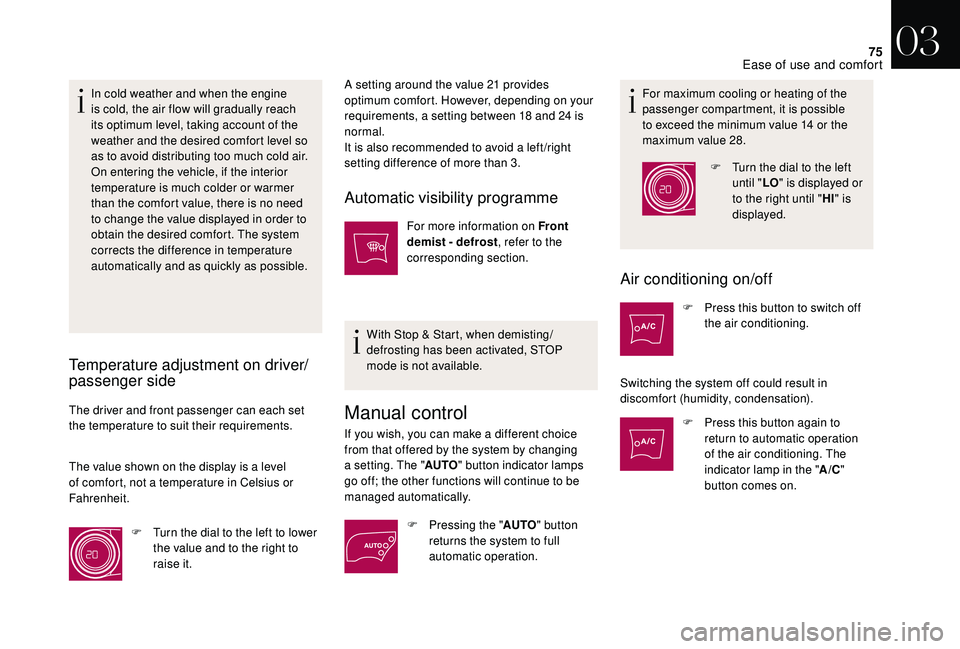
75
In cold weather and when the engine
is cold, the air flow will gradually reach
its optimum level, taking account of the
weather and the desired comfort level so
as to avoid distributing too much cold air.
On entering the vehicle, if the interior
temperature is much colder or warmer
than the comfort value, there is no need
to change the value displayed in order to
obtain the desired comfort. The system
corrects the difference in temperature
automatically and as quickly as possible.
Temperature adjustment on driver/
passenger side
The driver and front passenger can each set
the temperature to suit their requirements.
The value shown on the display is a level
of comfort, not a temperature in Celsius or
Fahrenheit.F
T
urn the dial to the left to lower
the value and to the right to
raise it. A setting around the value 21 provides
optimum comfort. However, depending on your
requirements, a setting between 18 and 24 is
normal.
It is also recommended to avoid a left /right
setting difference of more than 3.
Automatic visibility programme
For more information on Front
demist - defrost
, refer to the
corresponding section.
With Stop & Start, when demisting/
defrosting has been activated, STOP
mode is not available.
Manual control
If you wish, you can make a different choice
from that offered by the system by changing
a setting. The " AUTO" button indicator lamps
go off; the other functions will continue to be
managed automatically.
F
P
ressing the "AUTO" button
returns the system to full
automatic operation. For maximum cooling or heating of the
passenger compartment, it is possible
to exceed the minimum value 14 or the
maximum value 28.
F
T
urn the dial to the left
until " LO" is displayed or
to the right until " HI" is
displayed.
Air conditioning on/off
F Press this button to switch off the air conditioning.
Switching the system off could result in
discomfort (humidity, condensation). F
P
ress this button again to
return to automatic operation
of the air conditioning. The
indicator lamp in the " A/C"
button comes on.
03
Ease of use and comfort
Page 78 of 296

76
Adjusting the air distribution
F Press one or more buttons to direct the air flow towards:
-
t
he windscreen and side
windows (demisting or
def r o st ing),
-
t
he outer and centre air vents,
-
t
he footwells.
You can combine the three directions to obtain
the desired air distribution.
Adjusting the air flow
F Turn this control to the left to decrease the air flow or to the
right to increase the air flow.
The air flow indicator lamps between the two
fans come on progressively according to the
value requested.
Air intake/Air recirculation
F Press this button to recirculate the interior air. The button's
indicator lamp comes on.
Air recirculation enables the passenger compartment
to be isolated from exterior odours and smoke.
F As soon as possible, press this button again to permit
the intake of outside air and
prevent the formation of
condensation. The button's
indicator lamp goes off.
Avoid prolonged operation in interior air
recirculation mode (risk of misting and
deterioration of air quality).
"REST" function: ventilation with the
engine off
Even with the engine is off, you can operate the
ventilation for a few minutes.
For example, if you leave the vehicle,
ventilation can be provided to the passengers
who stay inside without having to start the
engine.
This function is available after switching on the
ignition, as well as after stopping the engine.
The availability period of the function depends
on the state of charge of the battery.
You can activate the "REST" function as long
as the air conditioning control displays are on. When the ignition is switched on
-
T
he control displays come on: the function
is available.
-
P
ressing the REST
button
activates the ventilation for
a few minutes. Activation of
the function is confirmed by
two dashes appearing in the
control displays and four air
flow level indicator lamps.
On stopping the engine
-
W
hile the control displays are still on: the
function is available.
- P ressing the REST
button
activates the ventilation for
a few minutes. Activation of
the function is confirmed by
two dashes appearing in the
control displays and four air
flow level indicator lamps.
Locking the vehicle has no effect on this
function.
-
T
he displays go off at the end of this period.
Pressing this button again before the end of
the period stops the ventilation completely: the
control displays go off and the function is no
longer available.
03
Ease of use and comfort
Page 79 of 296
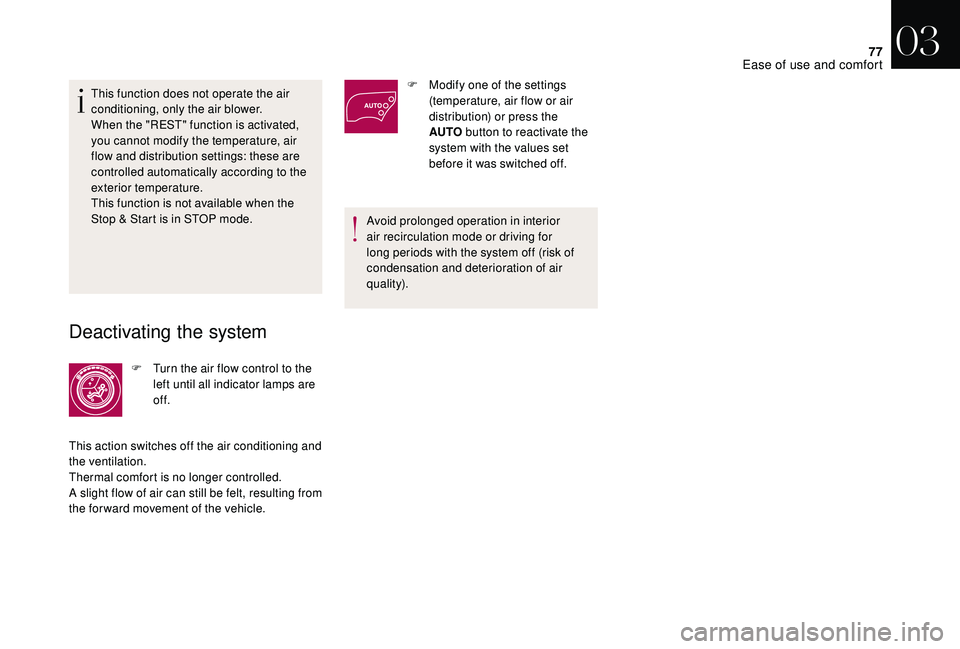
77
This function does not operate the air
conditioning, only the air blower.
When the "REST" function is activated,
you cannot modify the temperature, air
flow and distribution settings: these are
controlled automatically according to the
exterior temperature.
This function is not available when the
Stop & Start is in STOP mode.
Deactivating the system
F Turn the air flow control to the left until all indicator lamps are
of f.
This action switches off the air conditioning and
the ventilation.
Thermal comfort is no longer controlled.
A
slight flow of air can still be felt, resulting from
the for ward movement of the vehicle. F
M
odify one of the settings
(temperature, air flow or air
distribution) or press the
AUTO button to reactivate the
system with the values set
before it was switched off.
Avoid prolonged operation in interior
air recirculation mode or driving for
long periods with the system off (risk of
condensation and deterioration of air
quality).
03
Ease of use and comfort
Page 80 of 296
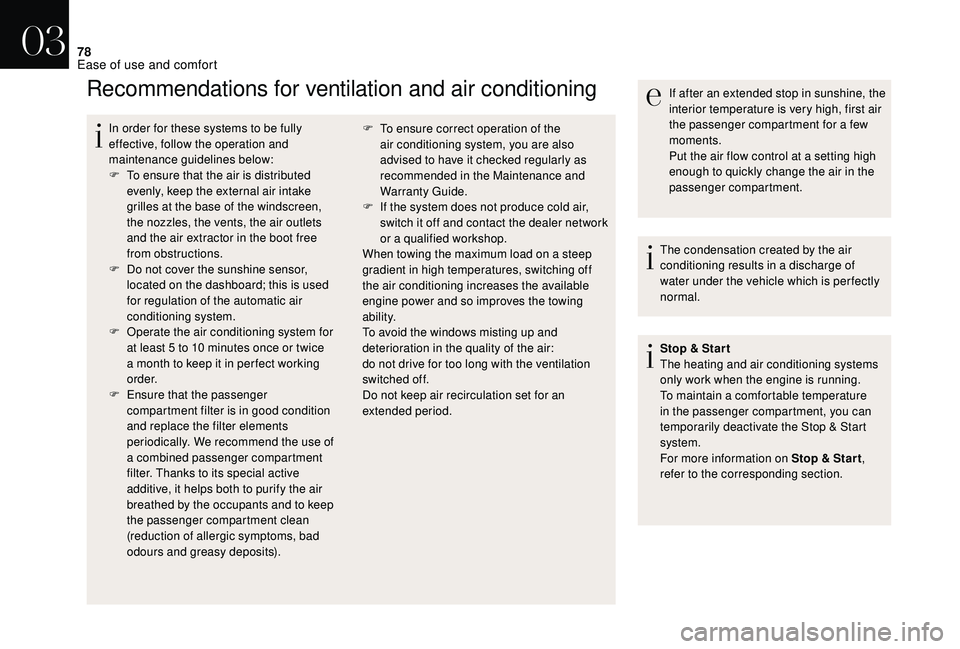
78
Recommendations for ventilation and air conditioning
In order for these systems to be fully
effective, follow the operation and
maintenance guidelines below:
F
T
o ensure that the air is distributed
evenly, keep the external air intake
grilles at the base of the windscreen,
the nozzles, the vents, the air outlets
and the air extractor in the boot free
from obstructions.
F
D
o not cover the sunshine sensor,
located on the dashboard; this is used
for regulation of the automatic air
conditioning system.
F
O
perate the air conditioning system for
at least 5 to 10 minutes once or twice
a month to keep it in per fect working
o r d e r.
F
E
nsure that the passenger
compartment filter is in good condition
and replace the filter elements
periodically. We recommend the use of
a combined passenger compartment
filter. Thanks to its special active
additive, it helps both to purify the air
breathed by the occupants and to keep
the passenger compartment clean
(reduction of allergic symptoms, bad
odours and greasy deposits). F
T o ensure correct operation of the
air conditioning system, you are also
advised to have it checked regularly as
recommended in the Maintenance and
Warranty Guide.
F
I
f the system does not produce cold air,
switch it off and contact the dealer network
or a qualified workshop.
When towing the maximum load on a steep
gradient in high temperatures, switching off
the air conditioning increases the available
engine power and so improves the towing
ability.
To avoid the windows misting up and
deterioration in the quality of the air:
do not drive for too long with the ventilation
switched off.
Do not keep air recirculation set for an
extended period. If after an extended stop in sunshine, the
interior temperature is very high, first air
the passenger compartment for a few
moments.
Put the air flow control at a setting high
enough to quickly change the air in the
passenger compartment.
The condensation created by the air
conditioning results in a discharge of
water under the vehicle which is per fectly
normal.
Stop & Star t
The heating and air conditioning systems
only work when the engine is running.
To maintain a comfortable temperature
in the passenger compartment, you can
temporarily deactivate the Stop & Start
system.
For more information on Stop & Star t ,
refer to the corresponding section.
03
Ease of use and comfort